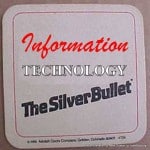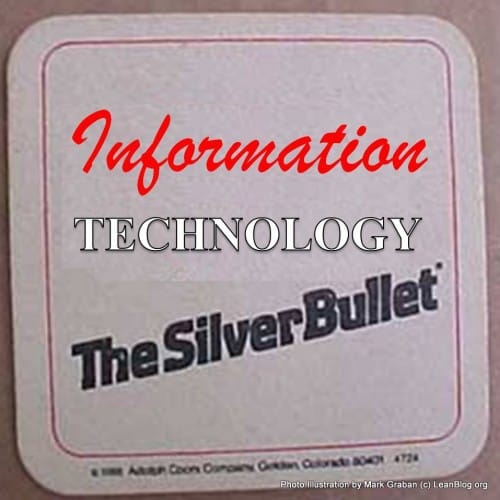 Lean thinkers and TPS advocates sometimes get a bad rap as being Luddites. That's not true, I'd say it's more that Lean thinkers have a healthy skepticism toward technology being a “silver bullet.” You typically need good process in addition to technology… and you need the right technology that serves your processes and your people (to quote The Toyota Way- Principle #8).
Lean thinkers and TPS advocates sometimes get a bad rap as being Luddites. That's not true, I'd say it's more that Lean thinkers have a healthy skepticism toward technology being a “silver bullet.” You typically need good process in addition to technology… and you need the right technology that serves your processes and your people (to quote The Toyota Way- Principle #8).
In recent years, we've all heard a lot about the promise of information technology from both sides of the political aisle (Obama and Gingrich). There's been lots of hype, but will the technology like CPOE – Computerized Physician Order Entry – live up to their promise of preventing errors and preventing medical harm and death? A new study says it might not…
The well-regarded patient safety organization, the Leapfrog Group has a new report out, says this release: “Leapfrog Announces New Report on the Safety of Electronic Prescribing in Hospitals.”
From their website summary of the report:
Health information technology could inadvertently result in harm to patients without proper monitoring, according to a new report issued today by The Leapfrog Group, an employer-backed health advocacy organization.
The report calls on federal officials to act quickly by building oversight requirements into health care IT regulations now being hammered out in Washington. The report also recommends actions that hospitals and CPOE technology companies should take to assure the quality and safety of these systems.
So there's the ‘it's not a silver bullet' warning.
Leapfrog continues:
Using a web-based simulation tool, 214 hospitals tested their computerized provider order entry (CPOE) systems for their ability to catch common medication errors, including errors that could lead to fatalities. The CPOE systems on average missed one-half of the routine medication orders and a third of the potentially fatal orders. Nearly all of the hospitals improved their performance after adjusting their systems and protocols and running the simulation a second time. The simulations were conducted from June 2008 to January 2010.
“Although this is a simulation using fictitious patients and medication orders, it should be a red flag for every hospital and information technology company in America,” said Leapfrog CEO Leah Binder. “The belief that simply buying and installing health information technology will automatically lead to safer and better care is a myth. Hospitals and vendors must continue to work together over time to ensure the effectiveness and efficiency of CPOE,” Binder noted.
Yes, you need good systems and protocols. Not just technology. No surprise to the Lean world.
If you are worried, as a patient – only 26% of hospitals have implemented these systems. I'm not saying we should avoid these systems. We just need to implement them correctly – with a process focus, making sure people are properly trained etc. The U.S. lags the rest of the Western world in CPOE adoption.
When it works, there are benefits (if you believe the Wikipedia page, my lazy reference):
Computerized physician order entry (CPOE) has been estimated to reduce the medication error rate by 80%, and by 55% for errors with serious potential patient harm,[4] and other studies have also suggested benefits.[5]
So, yes, this technology CAN help. There are studies that says CPOE reduces mortality, yet there are studies that suggest otherwise or, like this Leapfrog report, suggest caution is needed.
What's your experience, in your hospital? If you're reading this from a patient perspective, what are your thoughts?
Maybe we can all get these Coors Light (“The Silver Bullet”) style mouse pads made like this…
Please scroll down (or click) to post a comment. Connect with me on LinkedIn.
Let’s build a culture of continuous improvement and psychological safety—together. If you're a leader aiming for lasting change (not just more projects), I help organizations:
- Engage people at all levels in sustainable improvement
- Shift from fear of mistakes to learning from them
- Apply Lean thinking in practical, people-centered ways
Interested in coaching or a keynote talk? Let’s talk.
Join me for a Lean Healthcare Accelerator Trip to Japan! Learn More











Mark,
Excellent point! You need to fix the process / system first with the involvement of the people before installing the technology. We have seen this in manufacturing (ERP) for years – just put in the new IT system and it will solve your problems. It appears we are heading down the same path in healthcare. Let’s hope we can change the direction before its too late. I talk about this in “EHR and the Ghost of Technologies Past” here: http://piadvice.wordpress.com/2009/11/23/ehr-the-ghost-of-technologies-past/
There are no Silver Bullets, there’s just hard work!
Glenn
We use CPOE in my organization. It is amazing how much time logging on adds to process time. As we get more teams together caring for the patient, each role has to log off and then log on. For HIPPA reasons, a provider can’t leave the computer if he needs to leave the room for a short time (some lean work there!) and needs to lock/unlock the screen. This is very frustrating for providers.
The other barrier is making changes to CPOE. It forces the need for IS to make the change and they have long queues and priorities. When they do make the change, it is more implentation mindset and not experimental since someone doesn’t know how quickly they can get another change. It is not a nimble system.
Lastly, the system gives some ALERT FATIGUE. There are so many pop-ups or “REMINDER” or “ARE YOU SURE” that it is easy to click through them and not really read anymore. This is akin to how signs are not effective counter-measures.
Dear Mark,
Thank you for writing this and since you asked for the patient perspective here it is. As a patient rights advocate I promote the use of CPOE within the Meaningful Use rule. It is by no means a silver bullet. We are not looking for one “magical solution” to solve a host of problems with the United States medical system. CPOE does need to double checked by programs like Leapfrog but also patients and caregivers need access to the record themselves and provide another set eyes to catch errors within the record. As you point at the US does lag behind in adoption and implementation of these systems, as we get more people on board some of the early problems will work out by use. As more and more Doctors graduate with an expectation that data entry is part of good medicine we will get more and improvement. As cutting edge technology venders come on board to create better systems we will see even more improvement. Most importantly as patients become empowered and take ownership of their personal medical state we will get more positive outcomes.
We are in a phase of real change within medicine, and CPOE is part of that change.
Thanks, Regina
Thanks, Regina, for your comment. I’m not suggesting that we shouldn’t move forward with EHR and CPOE. There are clearly benefits if we can do it right. Thankfully, not everyone views the technology as a silver bullet and some organizations are wisely integrating process improvements with technology.
I’m concerned about the idea that we perhaps have to wait for the next generation. If (and there are conflicting studies) CPOE leads to more errors today (in the short-term), but will be better in the future, we should do we can to mitigate those today problems today… rather than waiting for the next generation, let’s do all we can to help today’s generation improve (or maybe we should slow down on the technology a bit then if we think today’s people can’t learn and adapt, or won’t).
As a patient myself, I don’t want to be harmed tomorrow by a technology that has outstripped people’s ability and/or willingness to use it effectively. I’m not willing to take one for the team in that regard.
Thanks for sharing your thoughts.
[…] Continue reading here: Report: CPOE Technology is Not a Silver Bullet (No Surprise … […]
[…] reason I’m getting involved is that Greg and Matt are keenly aware that software is not a silver bullet. An effective kaizen system requires building the right leadership style and culture. While […]